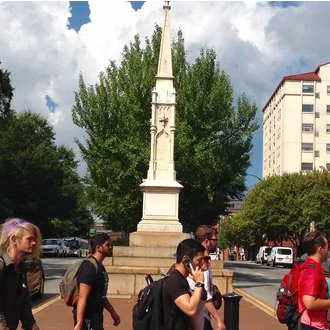Written by Sydney Leiter and Kanchana Balasubramanian
Photo Credit: Lee Shearer in the Athens Banner Herald
I began my education at the University of Georgia in the Fall of 2018. Like many students, I was wowed by campus, especially North Campus. Perhaps even more than that, I fell in love with Athens, which ultimately led me to UGA from out of state. I remember the excitement I felt walking from campus to Broad St. and back again, walking around (never under) the Arch. Like many other students, I never paid attention to the monument on the median of the intersection of Broad St. and College Ave. that stood directly across from the Arch, the symbol of our university and the state of Georgia.
I never looked at it or gave it a second thought until the summer of 2020 when the Black Lives Matter movement was back at the forefront of everyone’s mind after the murder of George Floyd. This heightened attention to anti-Black racism and white supremacy came to UGA in several forms, including the protesting of campus buildings named after enslavers and notorious racists. Mass protests also formed around that monument I had passed at least once a week for almost two years.
What I didn’t know as I strolled across the street was that the monument I never bothered to look at was a memorial to Confederate soldiers.
The monument was built in 1872 to honor dead Confederate soldiers from Athens-Clarke County and was among the first of these monuments in the United States. This was a monument honoring defenders of slavery and treason.
As time progressed, the racist symbol of the monument carried on, taking new forms. It became a meeting place for the Ku Klux Klan in the late 19th century and again in the 1920s. It became a meeting place again in the 1960s for protests against the integration of UGA and against Black voting rights. The monument continued to be a place to celebrate, protect and memorialize white supremacy.

In 2020, the monument became a meeting place for the opposite reason as supporters of Black Lives Matter gathered around it to call for its removal and an end to police brutality. These protestors were met with the same white supremacist violence the monument celebrates when they were tear-gassed and shot with rubber bullets by the National Guard.
It feels appropriate to note the location of this monument. It was not only on the street dividing downtown Athens from UGA, making it visible to locals and students alike, and across from the Arch. It was also located directly across from Holmes-Hunter Academic Building, the first building on UGA’s campus named after Black individuals, and the only building named after Black individuals until the opening of Black-Diallo-Miller Hall in 2022. Holmes-Hunter is named after Charlayne Hunter-Gault and Hamilton Holmes, the first Black students to be admitted to UGA who were met with violence and racist protests. Their building was the closest on campus to the Confederate monument. The monument, and therefore the Holmes-Hunter building, is also across from a historical marker on North Campus that refers to the Civil War as the War for Southern Independence, further romanticizing a war fought for the right to own and dehumanize Black people.

Meanwhile, I walked by all of this for two years without knowing this history and without even knowing what the monument stood for.
At the beginning of this article, I said “like many students”, I walked by the Confederate monument without a second thought, but it would be more accurate to say I did this like many white students. I have the privilege to not be aware of the white supremacy surrounding me in Athens as a white student at UGA unless I specifically seek out this hidden history. Students and residents of color, especially Black students and residents, do not have this same privilege.
As the protests happened during 2020, I remember seeing social media posts from my Black classmates about how they had specifically avoided the intersection of Broad and College to avoid seeing the monument, the glorification of the Confederacy and the marker that hides the truth about why the Civil War was fought. The history that I was ignorant of is still very much in the present for many students and residents of Athens.
Following the protests, the monument was removed from its location on Broad St. However, this was not done to remove the idolization of Confederate soldiers but to prevent it from being vandalized again. In 2021, the monument was relocated to Timothy Place, which is closer to the location of the only Civil War battle that occurred in Athens, Barber Creek. This location is further from the public eye as it isn’t directly between downtown and campus. The monument, and all of its history, is still in Athens, just more hidden now than before.
The Athens Confederate Monument is a visual representation of how slavery and the oppression of Black people were – and continue to be – celebrated and justified in the land. It supports Karen Warren’s theory of dominance through symbols of oppression and maintains that the land is still dominated by white colonial heritage. The statue is a physical representation of systematic racism and colonial subjugation. Black Lives Matter is a step towards inclusive and equitable societal change.
Sources and Suggested Reading:
The Even Uglier Truth Behind Athens Confederate Monument
Monumental Reckoning in Athens, GA
Holmes-Hunter Academic Building
Athens Confederate monument being reassembled in its new location
Glazebrook, T. (2023). Karen Warren’s Ecofeminism.
Gaard, G. (1997). Toward a Queer Ecofeminism. Hypatia, 12(1), 114–137.
Hooks, B. (2009). Belonging: A culture of place. Routledge. https://cir.nii.ac.jp/crid/1130000796723034112
Warren, K. J. (1990). The Power and Promise of Ecological Feminism.

